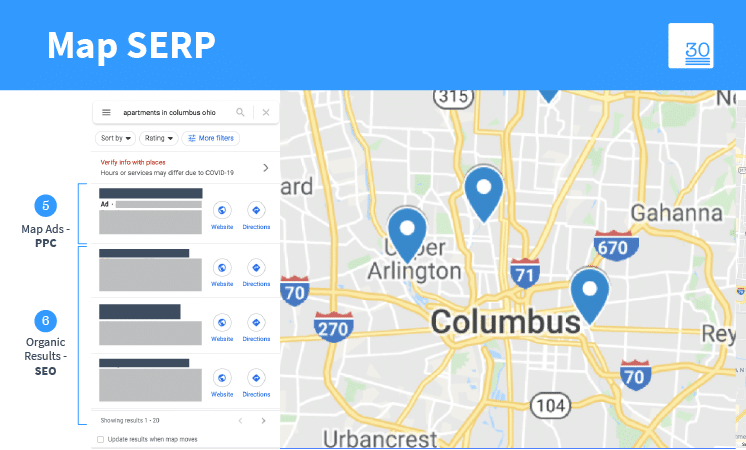Anatomy of a Search Engine Results Page
At 30 Lines, we’re asked “how” we get websites to rank higher in Google, and most times we need to delve a little deeper and look at “where” we need to rank as well. Many times it helps to break everything down by sections in the SERP (Search Engine Results Page). It’s important to look at each potential section of an apartment search and which 30 Lines’ products and tools (SEO or PPC) are useful to each.
We will look at four types of SERPs that are useful in the apartment industry, the sections that appear on each, and which products affect each section.

Normal SERP
Google’s main search page. This is where the majority of searches happen and where most people focus their marketing efforts. Google makes constant updates to this interface and it’s the most dynamic in terms of the different ways results are displayed. Not only will the results page change based on the search, but Google can also pull in results from other pages, like shopping and images.
1. Ads – PPC: These are typical Google Paid Search Ads. Using the Google Ads tool, we can bid on certain keywords, and appear at the top of the listings when people search. Because Google charges accounts on a per-click basis, the acronym we use is PPC (pay-per-click).
2. Ad Extensions – PPC: Ad Extensions are another part of our Paid Ads service, and come from Google Ads. They are a part of the overall paid campaign and can show up differently depending on what we want to display.
3. Local Map Pack – SEO: The Local Map Pack is the first section that’s affected by SEO (Search Engine Optimization). Google picks and chooses what it shows here (and in what order) based on a number of different website-based and Google My Business criteria like keyword matching, backlinks, review star rating, and a lot more.
4. Organic Results – SEO: Organic Results are the traditional placements for SEO. They depend on a similar, but not identical set of criteria from the Local Pack results.
Map SERP
30 Lines clients get over 14 times as many views on a map on Google as they do in Search, making the Map Search an invaluable tool to apartment marketers. Like the normal search results, the Map Search can be influenced by SEO through Google My Business or by PPC through Google Ads.
5. Map Ads – PPC: Google can also use paid bids for the map section. The official term for these are “Location Extensions” in the Google Ads tool.
6. Organic Results – SEO: Non-ad map placements also rely on SEO, just like the traditional organic text results. Google uses signals specifically from Google My Business in addition to criteria to like backlinks and content.

FAQ/Question Search
A perfect example of how the normal search page can change based on the search, an FAQ SERP isn’t actually a separate section on Google, but a result of Google’s algorithm changing results because the user asked it a question. For example, searching “apartments near me” will result in a typical “Normal SERP” vs when you ask “Do I need an ID to rent an apartment?” when an FAQ SERP appears.
7. Answers – SEO: When users ask a question of Google, they will typically get a different result than when they shop or search for a business. When Google answers a question directly, it’s using Schema, or “Structured Data.” Schema is one of the many tools at a website’s disposal used in SEO and is used to display info in the SERP itself.
8. Other FAQs/Answers – SEO: Although these are displayed differently than a main “answer” in the SERP, they are also the result of schema.

Image SERP
The Google Image search is one that can often get overlooked by digital marketers, but in reality, it can be an opportunity to increase brand awareness as well as generate interest and traffic.
9. Organic Results – SEO: Image searches are another result dependent on SEO for their placements. Google uses meta data called an “alt tag” to identify and sort images.

It’s always useful to keep in mind that all of these sections are affected by SEO and PPC in different ways. Understanding the “where” of ranking is just as important as the “how,” and can better inform marketing decisions like where to spend money, and what messaging to use for each tool.
Have questions about SERP or SEO? Drop us a line. We’re here to help.
